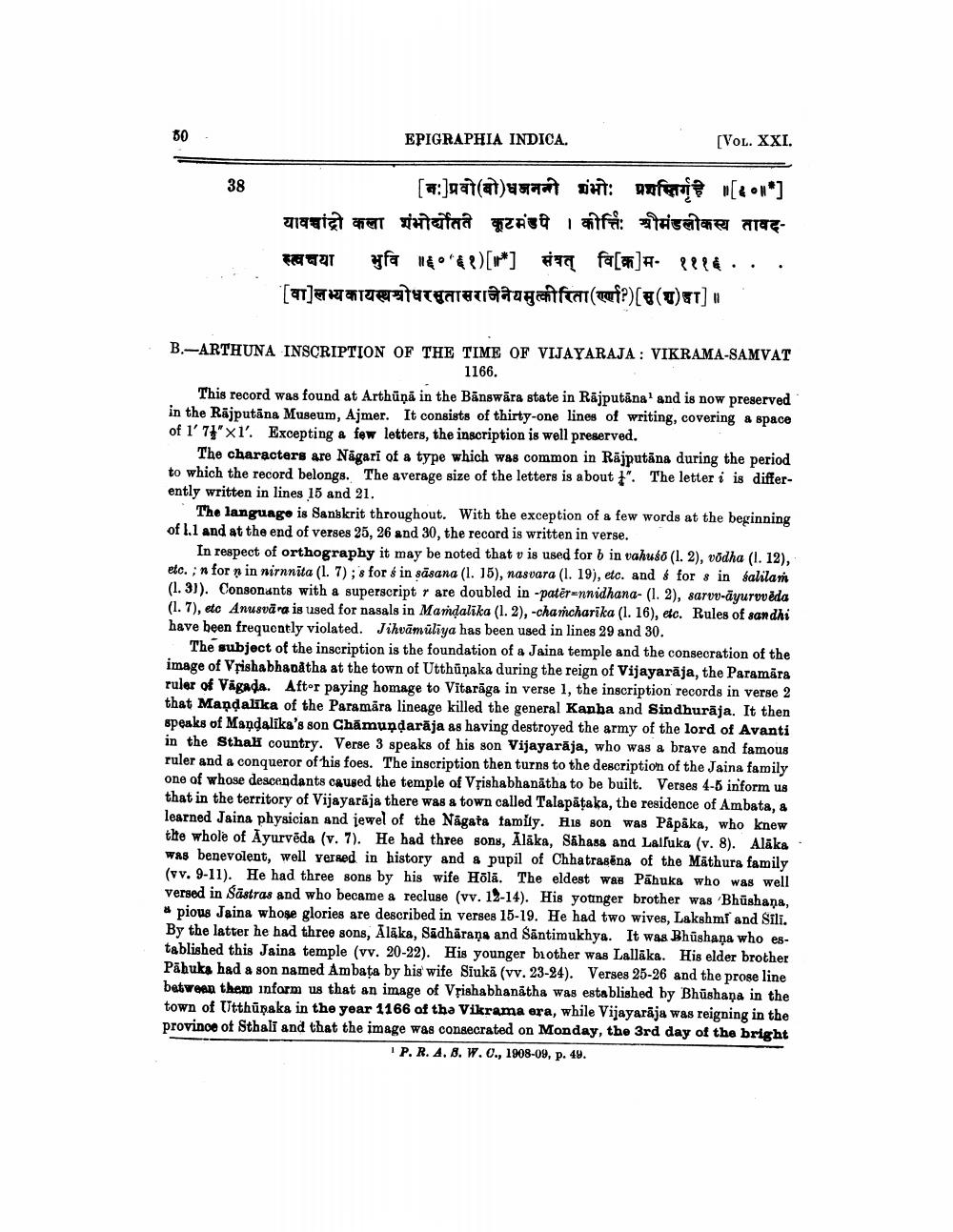________________
EPIGRAPHIA INDICA.
[VOL. XXI.
[w:]qat(at)uwa Daft: animajo [2 •v*] यावच्चांद्रो कला शंभो?तते कूटमंडप । कीर्तिः श्रीमंडलीकस्य तावद
a fa 40*) [ro] 87 fa[]# Pela... [21]*7*14eulutuarathaugantfcat (wf?)[U(U)] u
B.-ARTHUNA INSCRIPTION OF THE TIME OF VIJAYARAJA: VIKRAMA-SAMVAT
1166. This record was found at Arthūna in the Bānswära state in Rajputāna' and is now preserved in the Rājputāna Museum, Ajmer. It consists of thirty-one lines of writing, covering a space of 1' 71'x1'. Excepting a few letters, the inscription is well preserved.
The characters are Nägari of a type which was common in Rajputāna during the period to which the record belongs. The average size of the letters is about t". The letter i is differently written in lines 15 and 21.
The language is Sanskrit throughout. With the exception of a few words at the beginning of 1.1 and at the end of verses 25, 26 and 30, the record is written in verse.
In respect of orthography it may be noted that v is used for b in vahuso (1.2), vodha (1. 12), etc. in forn in niinnita (1. 7); 8 for ś in sāsana (1. 15), nasvara (1. 19), etc. and $ for sin salilar (1.3)). Consonants with a superscript 7 are doubled in -patēr=nnidhana- (1.2), sarvu-ayurveda (1. 7), etc Anusvāra is used for nasals in Mandalika (1.2), -chańcharika (1. 16), etc. Rules of sandhi have been frequently violated. Jihvām ūliya has been used in lines 29 and 30.
The subject of the inscription is the foundation of a Jaina temple and the consecration of the image of Vpishabha åtha at the town of Utthūņaka during the reign of Vijayarāja, the Paramārs ruler of Vägada. After paying homage to Vitarāga in verse 1, the inscription records in verse 2 that Mandalīka of the Paramāra lineage killed the general Kanha and Sindhurāja. It then speaks of Mandaliks's son Chămundarāja as having destroyed the army of the lord of Avanti in the Sthal country. Verse 3 speaks of his son Vijayarāja, who was a brave and famous ruler and a conqueror of his foes. The inscription then turns to the description of the Jaina family one of whose descendants caused the temple of Vțishabhanātha to be built. Verses 4-5 inform us that in the territory of Vijayaraja there was a town called Talapätaka, the residence of Ambata, a learned Jaina physician and jewel of the Nāgata family. H18 son was Pâpâka, who knew the whole of Ayurvēda (v. 7). He had three sons, Alaka, Sahass and Lalluka (v. 8). Aläka was benevolent, well versed in history and & pupil of Chhatrasēns of the Mathura family (vv. 9-11). He had three sons by his wife Hõla. The eldest was Pāhuka who was well versed in Sāstras and who became & recluse (vv. 12-14). His younger brother was Bhushana,
pious Jaina whose glories are described in verses 15-19. He had two wives, Lakshmi and Sili. By the latter he had three sons, Alūka, Sūdhāraṇa and Säntimukhya. It was Bhushana who established this Jaina temple (vv. 20-22). His younger brother was Lallāka. His elder brother Pāhuka had a son named Ambata by his wife Siukā (vv. 23-24). Verses 25-26 and the prose line between them inform us that an image of Vpishabhanātha was established by Bhūshaņa in the town of Utthūnaka in the year 1166 of tha Vikrama era, while Vijayarāja was reigning in the province of Sthali and that the image was consecrated on Monday, the 3rd day of the bright
P. R. A. 8. W.O., 1908-09, p. 49.




